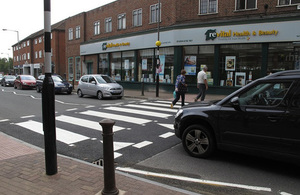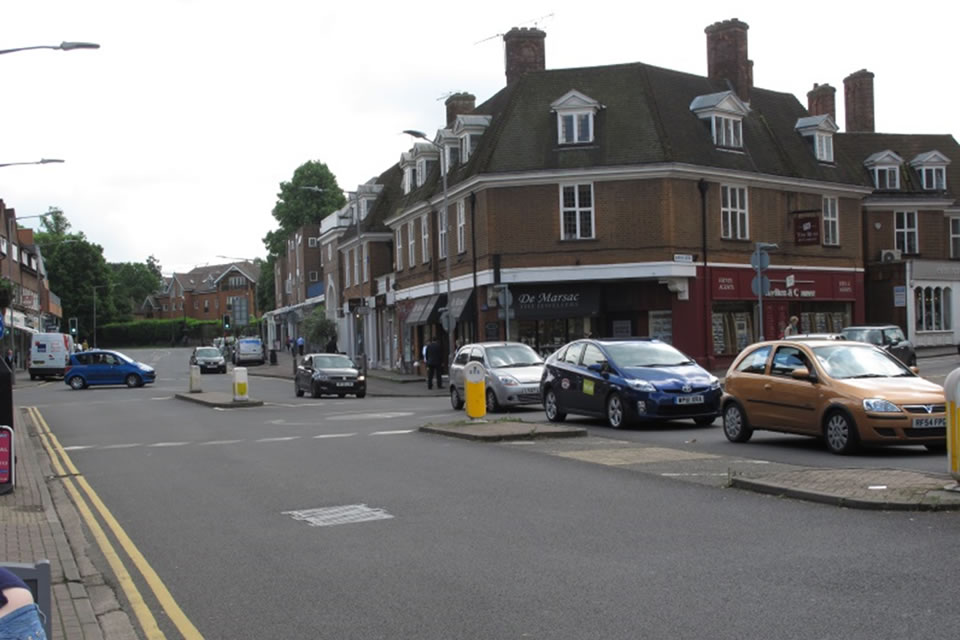Improving Beaconsfield town centre for cyclists and pedestrians
Reducing traffic speeds in Beaconsfield town centre to create a safer and more inviting environment for cyclists and pedestrians.

Raised zebra crossing in Beaconsfield.
What we did
We made improvements to 2 roundabouts and a number of side roads. This slowed down traffic and created a better environment for cyclists and pedestrians through a busy area of Beaconsfield town centre.
Measures to reduce traffic speeds included:
- installation of raised zebra crossings
- informal raised crossings
- kerb build-outs and tightening of corners to reduce entry speeds into side roads
- a central median strip installed along the length of Station Road, creating an informal crossing island for pedestrians and a right turn pocket for cyclists
Other key features included:
- advisory cycle lanes
- a new single lane mini-roundabout (as a traffic-calming measure)
- overrun areas for larger vehicles
These were complemented by improvements around Beaconsfield train station to improve conditions for pedestrians and cyclists.
The changes improved the look and feel of the area, encouraging greater use of local shops and services.
Why we did it
The double mini roundabout section on the B474, Station Road in Beaconsfield New Town was designed for motor vehicles, with wide traffic lanes on the roundabout and its approaches.

The double roundabout before the scheme.
These created an unsafe and uninviting environment for cyclists and were a significant barrier to cycling in the town. The existing environment was also problematic for pedestrians, with limited crossing points and wide side road junctions.
We wanted to encourage cycling to work, schools and colleges and the railway station.
How we did it
A key aspect of delivery was the involvement of the Beaconsfield Cycle Path Action Group (BCPAG) – a community group consisting of volunteers, schools, residents and councillors, supported by Beaconsfield Town Council, the county council and Sustrans.
Building on the Beaconsfield Transport Strategy, the group carried out extensive research into potential for cycling improvements across the town in order to increase cycling levels. Using this research BCPAG developed an aspirational cycle network for the town. It combined on-road and off-road facilities and enabled access to significant funding for safer routes to school for children and access to the town / rail station for all.
In addition to working with the community group, the wider community was kept engaged in the scheme through:
- the distribution of flyers notifying residents and businesses of the upcoming works to around 1,000 frontages, leaving copies in the library, town hall and rail station
- posting of details of the scheme and regular updates during the works on the council’s website and via Twitter
In advance of and during the construction itself, the site manager visited most businesses on Station Road regularly to resolve any issues and keep them informed.
The scheme was funded through the Local Sustainable Transport Fund and a combination of local funding pots with a contribution from the Department for Transport Cycle Safety Fund programme. The budgeted total scheme cost was £640,000, including improvements to access the station.
What we learned
Monitoring and review of the scheme recorded an increase in use and perceived safety. Over 75% of respondents described the scheme as either safe or at least as safe as before. Cycle usage along Station Road increased from 3% to 7% of modal share.
Development of design concepts is best led through an end user approach, in this case through the council’s work with the BCPAG.
Wide and detailed engagement with residents and stakeholders, in particular retail managers and owners, can help to address concerns from the community prior to the approval of the final design. Continuing this consultation during construction can also be beneficial as this can help maintain the communities understanding and help to retain their support.
An established community action group pushing solutions to established problems has a great impact locally, in particular around generating supportive press coverage.
Whilst essentially a cycle scheme, aimed at improving the safety of cyclists on Station Road, the scheme could only be successful through understanding the needs other modes, particularly walking.
Excellent feedback has been received by all parties involved in the project, including Sustrans, Chiltern Railways, the town and the county council, councillors, including the leader of Buckinghamshire County Council who helped the launch of the scheme and the Beaconsfield Cycle Paths Action Group.
The following are quotes from the general public regarding the scheme:
A great improvements for pedestrians and cyclists
Changes very good; slows down traffic, better for children
I cycle here two plus times a week, but sometimes more often because it feels safer
This scheme set a precedent showing what can be achieved across the town, helping to gain public support for the wider aspirations. With the additional work completed on developing the cycling strategy for Beaconsfield and with support and ongoing enthusiasm from BCPAG, the council is in a good position to bid for future funding to ensure that the whole network is completed.
This community-led approach means the project will be sustainable over the long-term. Local people have taken ownership of securing infrastructure, such as cycle parking and increasing cycling numbers through promotion at local events, led rides etc.
Transport for Buckinghamshire is a public/private sector partnership run by Buckinghamshire County Council and Ringway Jacobs to deliver highways services within Buckinghamshire.
Contact and further information
- email Rebecca Dengler, Transport Strategy Lead Officer, at rdengler@buckscc.gov.uk
- Beaconsfield Cycle Paths Action Group